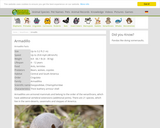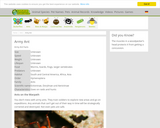9869 Results

This resource is a video abstract of a research paper created by Research Square on behalf of its authors. It provides a synopsis that's easy to understand, and can be used to introduce the topics it covers to students, researchers, and the general public. The video's transcript is also provided in full, with a portion provided below for preview:
"Deep-sea hydrothermal vent ecosystems host an array of macrofauna, including many invertebrates. These animals adapt to the extreme conditions by forging endosymbiotic relationships with chemoautotrophic bacteria. Phages, viruses that infect prokaryotes, can fundamentally affect endosymbiotic bacteria, but their specific roles in deep-sea vent endosymbionts are not yet known. A recent study utilized metagenomics, transcriptomics, and proteomics to examine the endosymbiotic phages associated with the deep-sea vent snail Gigantopelta aegis. These phages infected methane- and sulfur-oxidizing bacteria, and there was evidence of both lysogenic and lytic lifecycles. The genomes also showed evidence of an arms race between bacteria and phages, with the bacteria encoding defense systems like CRISPR–Cas to break down phage DNA and the phages encoding their own anti-defense mechanisms. The phages also had horizontally acquired auxiliary metabolic genes, which could benefit replication..."
The rest of the transcript, along with a link to the research itself, is available on the resource itself.
- Subject:
- Biology
- Life Science
- Material Type:
- Diagram/Illustration
- Reading
- Provider:
- Research Square
- Provider Set:
- Video Bytes
- Date Added:
- 10/13/2021
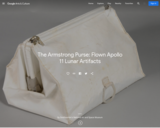
The bag itself was immediately recognizable in that the ALSJ long has had a page devoted to what the astronauts referred to as a McDivitt Purse.
- Subject:
- Applied Science
- Astronomy
- Engineering
- History
- Physical Science
- Material Type:
- Reading
- Provider:
- National Air and Space Museum
- Author:
- National Air and Space Museum
- Date Added:
- 10/04/2022
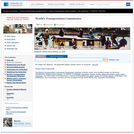
This site makes available for viewing the nearly nine hundred images of modes of transportation taken by American photographer William Henry Jackson in North Africa, Asia, Australia, and Oceania. The site allows searches by subject and Keyword, and gives archival information about it.
- Subject:
- History
- U.S. History
- Material Type:
- Reading
- Provider:
- Library of Congress
- Provider Set:
- American Memory
- Date Added:
- 09/07/2000
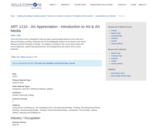
This entry-level course is designed to help you gain a general appreciation for art as well as to help you develop a working vocabulary for the knowledgeable analysis of art based on the Visual Elements and the Principles of Design. The syllabus is included in the course and contains the course objectives, student learning outcomes, list of assignments and names of the course textbooks.
- Subject:
- Art History
- Arts and Humanities
- Graphic Arts
- Visual Arts
- Material Type:
- Assessment
- Full Course
- Homework/Assignment
- Reading
- Syllabus
- Textbook
- Provider:
- SkillsCommons
- Author:
- Kelly Joslin
- Date Added:
- 01/20/2022
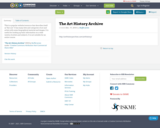
This is a popular website/resource that describes itself as "fair use". It has many lists and categories of art and artists with some biographical material and images. It is useful for looking up basic information on a wide variety of artists and subjects. It is not suitable for an entire course.
- Subject:
- Arts and Humanities
- Material Type:
- Homework/Assignment
- Reading
- Date Added:
- 05/30/2018
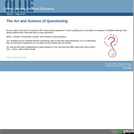
Art & Science of Questioning
- Subject:
- Education
- Material Type:
- Activity/Lab
- Reading
- Provider:
- AEA
- Provider Set:
- OLLIE
- Author:
- Evan Abbey
- Date Added:
- 12/01/2016
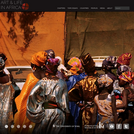
This site presents a program that places art in the context of people's lives so our students will understand how important and effective a tool art is in solving problems and overcoming adversity. The student will recognize that Africans sometimes face problems that are similar to his own, and while the solutions Africans create may look different than ours, they are logical and effective.
- Subject:
- Art History
- Arts and Humanities
- Material Type:
- Activity/Lab
- Lesson Plan
- Reading
- Provider:
- University of Iowa
- Author:
- Christophe D. Roy
- Date Added:
- 07/14/2000

This resource is a video abstract of a research paper created by Research Square on behalf of its authors. It provides a synopsis that's easy to understand, and can be used to introduce the topics it covers to students, researchers, and the general public. The video's transcript is also provided in full, with a portion provided below for preview:
"The tick-borne parasite Theileria annulata can cause life-threatening illness in cows. Buparvaquone is the only available drug treatment, but the incidence of buparvaquone (BPQ) resistance is increasing so alternative therapies are needed. To help, researchers recently tested the efficacy of the anti-malaria drug artemisinin and its derivatives against T. annulata infection. Artemisinin itself wasn’t effective, but all of its derivatives were able to selectively kill parasite-infected cells. Artesunate (ARS) and dihydroartemisinin (DHART) were especially potent and either drug could act synergistically with BPQ, enhancing the parasite-killing effects of the individual compounds. Investigation of the mechanism revealed that ARS and DHART caused oxidative stress and DNA damage in the infected cells which activated the protein p53 and the caspase-dependent cell death pathway..."
The rest of the transcript, along with a link to the research itself, is available on the resource itself.
- Subject:
- Biology
- Life Science
- Material Type:
- Diagram/Illustration
- Reading
- Provider:
- Research Square
- Provider Set:
- Video Bytes
- Date Added:
- 04/24/2023
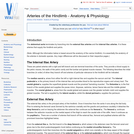
Although the information on this page is based around the anatomy of the canine hindlimb, it is essentially the anatomy of the arteries in domestic species. Any major differences will be discussed on their respective pages
- Subject:
- Anatomy/Physiology
- Life Science
- Material Type:
- Diagram/Illustration
- Reading
- Provider:
- WikiVet
- Provider Set:
- Anatomy & Physiology
- Date Added:
- 02/05/2015

This resource is a video abstract of a research paper created by Research Square on behalf of its authors. It provides a synopsis that's easy to understand, and can be used to introduce the topics it covers to students, researchers, and the general public. The video's transcript is also provided in full, with a portion provided below for preview:
"Colorectal cancer (CRC) is one of the most common gastrointestinal malignancies, and 40% of cases are related to mutation of the oncogene KRAS. However, no KRAS-targeting drugs are currently available for cancer treatment, and patients with KRAS mutations are insensitive to anti-EGFR therapy, which is often used for CRC. To improve treatment options, a new study tested the combined effects of the drugs artesunate and WNT974 on KRAS-mutant CRC. In vitro, the combination synergistically reduced CRC growth and decreased KRAS protein levels and activity, while inducing KRAS degradation via the ubiquitin–proteasome pathway, thereby reducing the oncogene’s influence. Specifically, the induced KRAS degradation was mediated by upregulation of ANAPC2, as well as upregulation of β-TrCP and GSK-3β. In addition, the combination treatment suppressed the PI3K/Akt/mTOR pathway, which is downstream of KRAS and supports tumor growth..."
The rest of the transcript, along with a link to the research itself, is available on the resource itself.
- Subject:
- Biology
- Life Science
- Material Type:
- Diagram/Illustration
- Reading
- Provider:
- Research Square
- Provider Set:
- Video Bytes
- Date Added:
- 05/18/2022
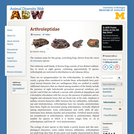
Arthroleptidae: Information
- Subject:
- Life Science
- Zoology
- Material Type:
- Reading
- Provider:
- University of Michigan Museum of Zoology
- Provider Set:
- Animal Diversity Web
- Author:
- Heather Heying (author)
- Date Added:
- 03/07/2005
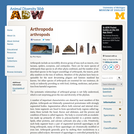
Arthropoda: Information
- Subject:
- Life Science
- Zoology
- Material Type:
- Reading
- Provider:
- University of Michigan Museum of Zoology
- Provider Set:
- Animal Diversity Web
- Author:
- Phil Myers (author), Museum of Zoology, University of Michigan
- Date Added:
- 03/07/2005
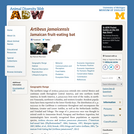
Artibeus jamaicensis: Information
- Subject:
- Life Science
- Zoology
- Material Type:
- Reading
- Provider:
- University of Michigan Museum of Zoology
- Provider Set:
- Animal Diversity Web
- Author:
- Antonia Gorog (author), University of Michigan
- Date Added:
- 03/07/2005

Courses on Artificial Intelligence (AI) and Librarianship in ALA-accredited Masters of Library and Information (MLIS) degrees are rare. We have all been surprised by ChatGPT and similar Large Language Models. Generative AI is an important new area for librarianship. It is also developing so rapidly that no one can really keep up. Those trying to produce AI courses for the MLIS degree need all the help they can get. This book is a gesture of support. It consists of about 95,000 words on the topic, with a 3-400 item bibliography.
- Subject:
- Applied Science
- Computing and Information
- Information Science
- Material Type:
- Reading
- Textbook
- Provider:
- SoftOption
- Author:
- Martin Frické
- Date Added:
- 07/28/2023
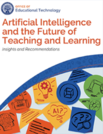
The U.S. Department of Education Office of Educational Technology’s new policy report, Artificial Intelligence and the Future of Teaching and Learning: Insights and Recommendations, addresses the clear need for sharing knowledge, engaging educators, and refining technology plans and policies for artificial intelligence (AI) use in education. The report describes AI as a rapidly-advancing set of technologies for recognizing patterns in data and automating actions, and guides educators in understanding what these emerging technologies can do to advance educational goals—while evaluating and limiting key risks.

Artificial Intelligence (AI) promises to offer tremendous opportunities for service excellence, creation of newer domain of employment avenues, and in the process augment industrial and economic growth for countries. The question, however, is India ready to embrace AI and pave for a new technology revolution? India’s history does indeed support this possibility. In the past, starting in the late 1980s, India successfully clasped the computer revolution bubble and took almost a decade to become an information technology (IT) leader in the world. Today, the Indian IT sector contributes significantly to the country’s GDP and is among the highest employment opportunity provider in the country. The journey of India as an IT major, however, has not been without its ups and downs.
- Subject:
- Arts and Humanities
- Computer Science
- Material Type:
- Reading
- Author:
- Prithvi Roy
- Date Added:
- 08/27/2020
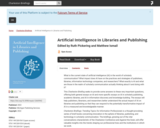
What is the current state of artificial intelligence (AI) in the world of scholarly communication? What impact does AI have on the practices and strategies of publishers, libraries, information technology companies, and researchers? What exactly is AI and what are those in the realm of scholarly communication actually thinking about it and doing with it?
This Charleston Briefing seeks to provide some answers to these very important questions, offering both general essays on AI and more specific essays on AI in scholarly publishing, academic libraries, and AI in information discovery and knowledge building. The essays will help publishers, librarians, and researchers better understand the actual impact of AI on libraries and publishing so that they can respond to the potentially transformative impact of AI in a measured and knowledgeable manner.
"Charleston Briefings: Trending Topics for Information Professionals" is a thought-provoking series of brief books concerning innovation in the sphere of libraries, publishing, and technology in scholarly communication. The briefings, growing out of the vital conversations characteristic of the Charleston Conference and Against the Grain, will offer valuable insights into the trends shaping our professional lives and the institutions in which we work.
- Subject:
- Applied Science
- Computer Science
- Information Science
- Social Science
- Material Type:
- Reading
- Author:
- Amy Brand
- Catherine Nicole Coleman
- Daniel W. Hook
- Haris Dindo
- James W. Weis
- Michael A. Keller
- Ruggero Gramatica
- Simon J. Porter
- Todd A. Carpenter
- Date Added:
- 02/06/2024

This resource is a video abstract of a research paper created by Research Square on behalf of its authors. It provides a synopsis that's easy to understand, and can be used to introduce the topics it covers to students, researchers, and the general public. The video's transcript is also provided in full, with a portion provided below for preview:
"Despite their known benefits, chemotherapy and other cancer treatments can take a toll on patients. Side effects such as hair loss, nausea, immune system suppression, fatigue, cognitive impairment, and infertility are common. The reason is that many cancer-fighting treatments target cells that quickly reproduce, which is true of cancer cells but also of other, healthy cells in the body, including blood cells and those lining the gastrointestinal tract. Is it possible to target only cancerous tissues with therapeutic drugs so that healthy organs remain unaffected? Researchers at the RIKEN Cluster for Pioneering Research in Japan are engineering molecules to do just that. The team showed that artificially designed gold-based enzymes (or metalloenzymes) can be used to guide drug delivery through a technique called selective cell tagging therapy. These metalloenzymes are studded with sugar molecules that can bind to specific proteins called lectins displayed on the surface of cancer cells..."
The rest of the transcript, along with a link to the research itself, is available on the resource itself.
- Subject:
- Applied Science
- Health, Medicine and Nursing
- Material Type:
- Diagram/Illustration
- Reading
- Provider:
- Research Square
- Provider Set:
- Video Bytes
- Date Added:
- 10/12/2021
